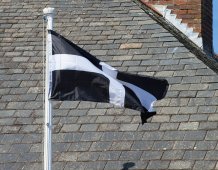Articles

It is estimated around 2,000 people have Cornish language proficiency.
Community action and a higher profile in schools key to growth of Cornish language
Community activism and a higher profile in schools will be essential for the numbers speaking Cornish to increase, an expert in the language has said.
Grass-roots efforts which boosted the number of people speaking Irish in Northern Ireland could be a blueprint for the growth of Cornish, according to Kensa Broadhurst, from the University of Exeter’s Institute of Cornish Studies,
In a speech to the Cornish Language Research Network, Skians, 2020 conference, Miss Broadhurst called for Cornish to become part of the National Curriculum, and for more resources and volunteers to help young people learn the language.
Miss Broadhurst, a former languages teacher, is researching how languages become extinct, and efforts to resurrect them. This includes the revival of Irish in Northern Ireland, and how this can provide a model for reviving Cornish.
During the past 40 years local groups in Belfast have established Irish-speaking nursery schools and evening language classes, which eventually were given state funding. Communities also set up an Irish newspaper and magazines, bookshops, language classes for the unemployed and social clubs, language festival and Irish programmes on Radio Ulster.
Miss Broadhurst said: “Northern Ireland is steps ahead of Cornwall in the way the language is promoted within the community and through official status and there are lessons for us in their efforts.
“For the use of Cornish to grow it needs to be part of the National Curriculum as a modern or ancient foreign language. For Cornish to thrive we need more resources and training for teachers. Currently the language relies on volunteers to survive. It needs the status of being a National Curriculum subject so it becomes part of the school day.
“Growth in Cornish is driven by its use in some technology, by musicians or writers, in folk music and choirs. We also have Cornish church services and radio programmes, and the bible has been translated into Cornish, and there are specialist bookshops. For it to have a real revival we need appropriate teaching materials and teachers.
“We are likely to see more progress with community involvement, rather than top-down policies with unrealistic targets. People need to see use of the language is empowering rather than just harking back to an idealised past. State-aid can be helpful, as well as it doesn’t undermine people’s right to control.”
Additional Irish language schools for children were common in Northern Ireland by the 1980s, and by 1978 people could study Irish language and literature at the University of Ulster. By the 1990s there was an Irish-language secondary school, and ten per cent of people said they spoke Irish on the 1991 census. The use of the language officially continues to be a sensitive political topic.
Around 500 people declared they could speak Cornish on the last national census in 2011. Cornish-language magazines were established in the 1930s and 1950s. Adult education classes in Cornish have been available since the 1980s and last year 80 students took exams in the language. It is estimated around 2,000 people have Cornish language proficiency.
There is also a Cornish nursery school, where parents can take lessons in the language, and extensive resources and teachers who want to introduce Cornish into their school. Before the National Curriculum was introduced in the 1980s Cornish was taught at a handful of schools, but following this it was confined to lunch and after school clubs because of teacher commitment.
Cornish was scrapped as a GCSE subject in 1996 because of the low number of candidates taking the exam. The language has also attracted, off and on, Government and European Union funding.
Date: 12 November 2020
